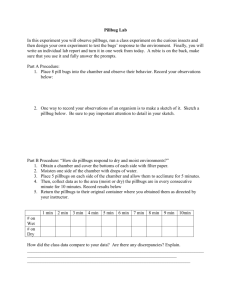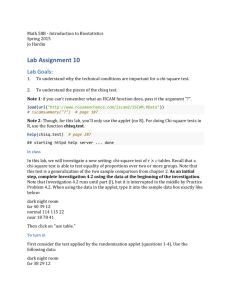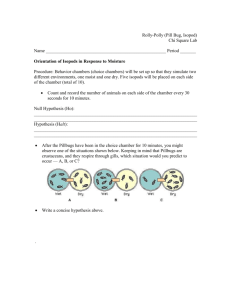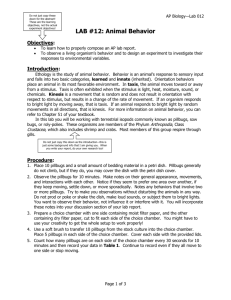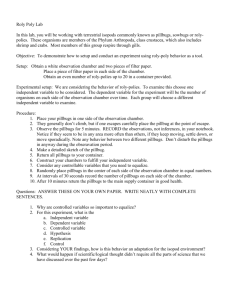Animal Behavior Lab
advertisement
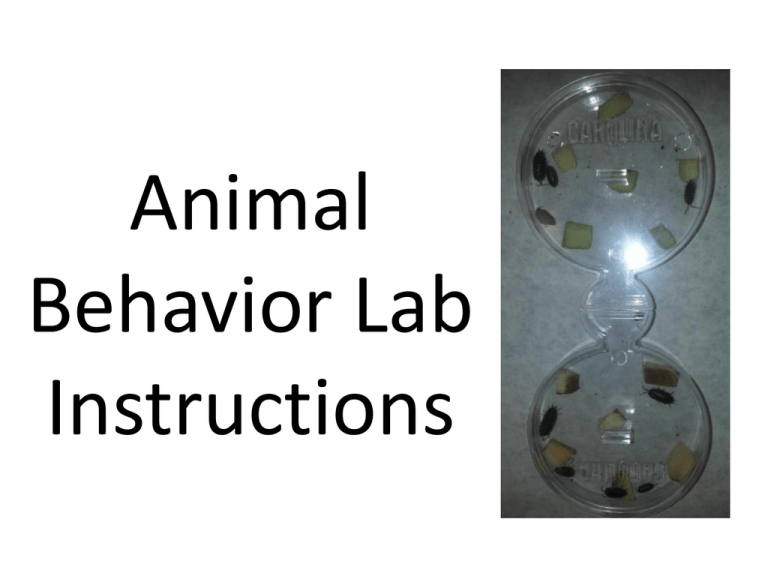
Animal Behavior Lab Instructions How to perform an Investigation in AP Biology: The Animal Behavior Lab Some Background Information • • • • • • • • • • • • • • “Iso” means similar/equal “Pod” means foot It has 14 legs. It has a segmented body. Also, known as the “Rollie Pollie”, “Roly-Polie”, and “Sow bugs” It is not an insect. Phylum: Arthropoda Class: Crustacea ( same class as Crustaceans like lobster, shrimp, and crabs. They breath through gills. Genus: Armadillidium Species: vulgare The Animal Behavior Lab has to do with Ethology Ethology – The study of animal behavior Couple of terms you need to know: Taxis: animal moves toward or away from stimulus. Kinesis: random movement without respect to stimulus. Just a mental image to help you remember: When you get in a taxi, do you tell the driver to take you to a specific place towards somewhere? Or just drive around to where ever he wants to and then let you out? Check for understanding: • What do each of these mean? • • • • • • • What is the stimulus? Which way is negative? Which way is positive? What does phototactic mean? What does chemotactic mean? What does Geotactic mean? I am going away from light? Your hypothesis • • • • • You will need both a null and alternate Null Alternate Sample: Null: There is no preference difference in moist and wet environments. • Pill bugs prefer moist environments Guided portion of the lab • 1. Place 15 pillbugs in your choice chamber gently with a paintbrush. • 2. Make observations for 10 minutes. • What do they look like? • How are they moving within the chamber? • How are they interacting with each other? • Remove the pillbugs. Guided portion of lab cont. 2. Place a moist filter paper on one end of the choice chamber and a dry filter paper on the other end of the filter paper. 3. Place 5 pillbugs in each end of the chamber and 5 in the middle gently with a small paint brush. 4. At 10 minutes, count the number on each side. This will have given them enough time to make a decision. Collecting Data • Make a small table similar to the one below. This was actually a table given for this lab on the AP Exam. Remember you are using pillbugs and wet vs. dry. Analyzing Your Data • If you look at the flow chart in your lab station manual, you will see that we collected discrete data. (follow the pink) • Our tool box will have consisted of expected and observed values. • We will use a bar graph. • Then we will use the ChiSquare test. The bar graph Title: Y-axis label: X-axis label: Independent Variable: Dependent Variable: . Methods of Analyzing your Data You can organize your data for calculating Chi-Square in a table like the one below. This is an actual sample from the AP Exam 2012. Now find that Chi-Square value (critical value) on the Degree of Freedom chart below. This is the actual chart available to you on the exam. • Will you be rejecting the null hypothesis? For the guided lab: • You will not be assembling a mini-poster, however, all of the information must be in your lab notebook. • Site references later for your back-ground information on mini-poster; • Don’t forget AP Lab Manuals, as a source Now it’s time to design your own experiment in Animal Behavior. Before you get started: Follow pre-lab design rubric. • You will need a composition book to record the following: (See rubric in lab station manual) • • • • • • • • • • • • 1. Members of your work group 2. Primary question for investigation 3. Background observations and contextual information – support why? 4. Hypotheses and rationale for the investigation 5. Experimental design – strategies/tools for testing hypothesis, using appropriate controls, and variables 6. Materials required (Make a sticky note shopping list for your lab station) 7. Safety issues 8. Procedure in sufficient detail so that someone could replicate your results. AT THIS POINT, YOU MUST GET MY APPROVAL BEFORE BEGINNING EXPERIMENTATION. 9. Results, including graphs, tables, drawings or diagrams, and statistical analysis 10.Conclusion and discussion - Was the hypothesis supported? What additional questions remain for further investigation? 11. References Example of Mini-Poster • Mini – Poster Requirements • • Title • Abstract – (like NFRSEF abstract from Science Fair) • Introduction – with primary question, background (like a review of Lit), and hypothesis (null and alternate, please) • Methodology – Materials; Design • Results, including appropriate graphs and descriptive statistics, tables/charts, and statistical analysis information (test and interpretation) • Conclusions: your interpretation of your results based on your hypotheses, including Reject Null or Fail to reject null, etc. • Literature cited. Evaluation • You will present your findings during a gallery walk of your peers. • All groups will prepare for presentation and set up meaningful mini-poster. • Group members will rotate out and visit other lab stations for presentations. • This first investigation will be graded by your group members, your peers, and me! College Board References you must be included in all investigative labs: • AP Dirty Dozen number 12 – this is located in the large notebook for your lab station • AP Investigation number 11 – this is located in the 2 green notebooks for your lab station. • All of your references need to be in APA format.

